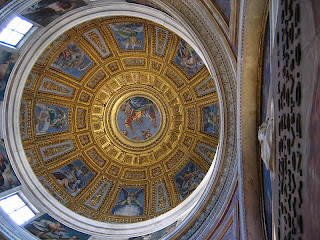The next day we had reservations for the Villa Borghese, easily one of the world's greatest "small" museums, and living proof that while you can never have enough Bernini, it
is possible to have too much Caravaggio. The Borghese collection has not merely a no pix policy; they actually confiscate your camera as you enter. So there will be no pix from me. Nevertheless, you can go to
www.galleriaborghese.it to see photos of the major works. Vicki actually likes the Caravaggios; I liked his David and Goliath, and The Fruit. We both liked Bernini's Apollo and Diana, the most exquisite sculpture I have seen, and Canova's Pauline Bonaparte. I liked all the Bernini works. The museum has timed admissions and a two-hour limit, every minute of which we used. [See posts from later years...when they finally decided to permit fotos].
 |
Pines of Rome, in the Villa Borghese park; Respighi has always been my favorite Italian composer
|
 |
Villa Borghese
|
 |
In the giftstore, Caravaggio's The Fruit
|
 |
Back in the park, a very eclectic place
|
 |
Nice Goethe statue, among many others
|
 |
And everywhere you look, another obelisk;
Rome has nearly as many obelisks as churches
|
 |
From the Belvedere, the King Victor Emmanuel monument,
a celebration of the newly united Italy's first ruler (1861),
completed in 1911, built over both Roman ruins
and Catholic churches (the unification was completed
when Garibaldi's and Victor-Manny's armies defeated
the Papal armies; many Romans don't like Il Vittoriano
|
 |
Looking down on the Piazza del Populo, from the Belvedere
|
 |
In the Piazza; nice symmetry, huh?
|
 |
Looking back to the Belvedere
|
 |
Arch of the Via Flaminia, northern portal to the city
|





















































